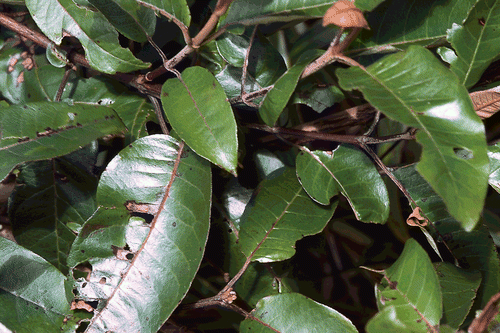
© Thomas Brendler
Harungana madagascariense Lam. ex Poir., Clusiaceae
Vernacular names: Bois Harongue (Mauritius), Fohatra, Fohatse, Haronga, Harongana, Miangaroka (Madagascar).
Geographical distribution: Tropical Africa. Native to Senegal, Sudan, Angola, Zimbabwe, Mozambique and Madagascar, Mauritius and Reunion.
Description: Shrub or tree 2-12 m, branched, with scaly bark and orange latex becoming red on exposure to air. Leaves with 0.5-2.5 cm long petiole; leaf blade oblong or oblong-oval, or elliptic, 5-22 × 3-14 cm, acute or shortly acuminate. Inflorescence corymbiform to pyramid-shaped, reaching 20 × 25 cm. Flowers numerous, fragrant, about 3 mm in diameter. Drupe yellow to orange, spherical, 3-4 × 3-4 mm, containing 5 pyrenes, each enclosing 1-4 curved cylindrical, 2 mm long seeds.
Chemical constituents: Chrysophanic acid was derived from leaf, bark and the alcoholic preparation of H. madagascariensis. Screening of the aqueous stem bark extract showed the presence of glycosides, saponins, tannins, sterols, anthraquinones, fats and oils. Bark and leaf contain anthrone derivatives such as harunganin and madagascin. The leaves contain hypericin, pseudohypericin and small amounts of quercetin. Also present are flavonol glycosides, tannins (especially condensed epicatechins and proanthocyanidins) and phytosterols.
Medicinal uses: Bark and leaf are used to treat dyspepsia and mild exocrine pancreatic insufficiency. The reddish sap obtained from the bark or stems is used as a styptic and is applied topically to treat various skin diseases, wounds, leprosy and itch.
Known biological activities: Leaf extracts have shown antibacterial and moderate anti-diarrhoeal activity, extract of the stem bark showed antiinflammatory properties, harunmadagascarins A and B, harunganol B and harunganin anthrone exhibited significant antioxidant activity, bazouanthrone, feruginin A, harunganin, harunganol A, harunganol B, friedelan-3-one and betulinic acid were found to be active against Plasmodium.
